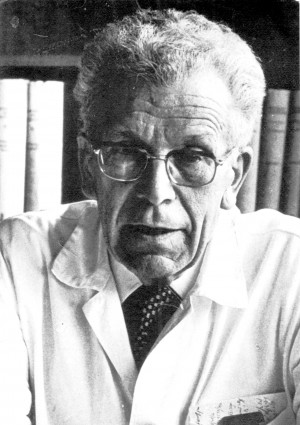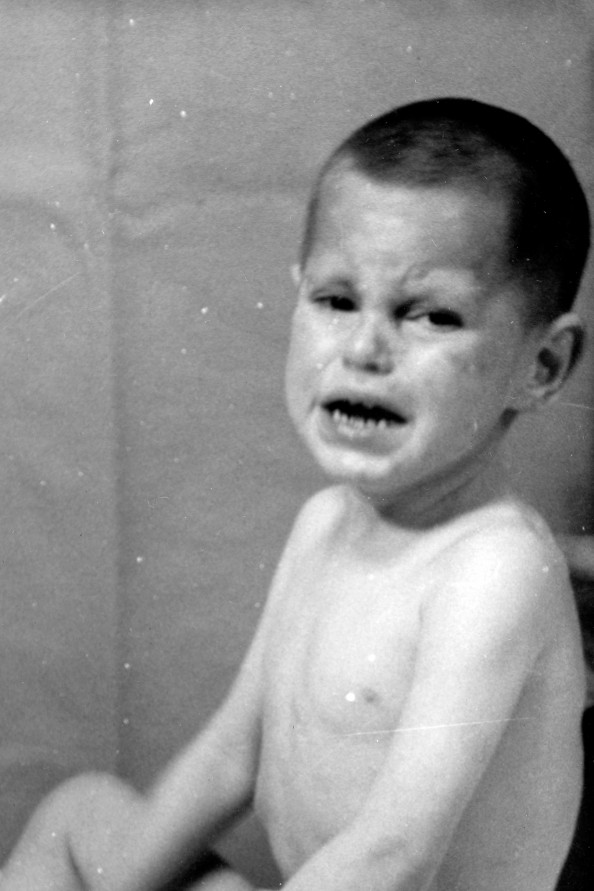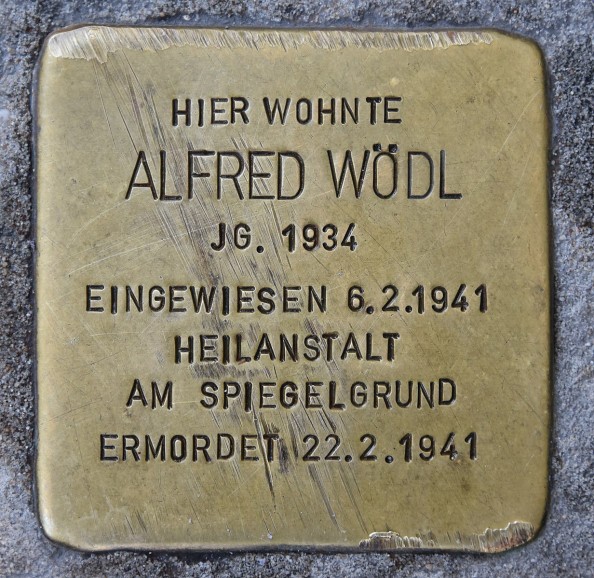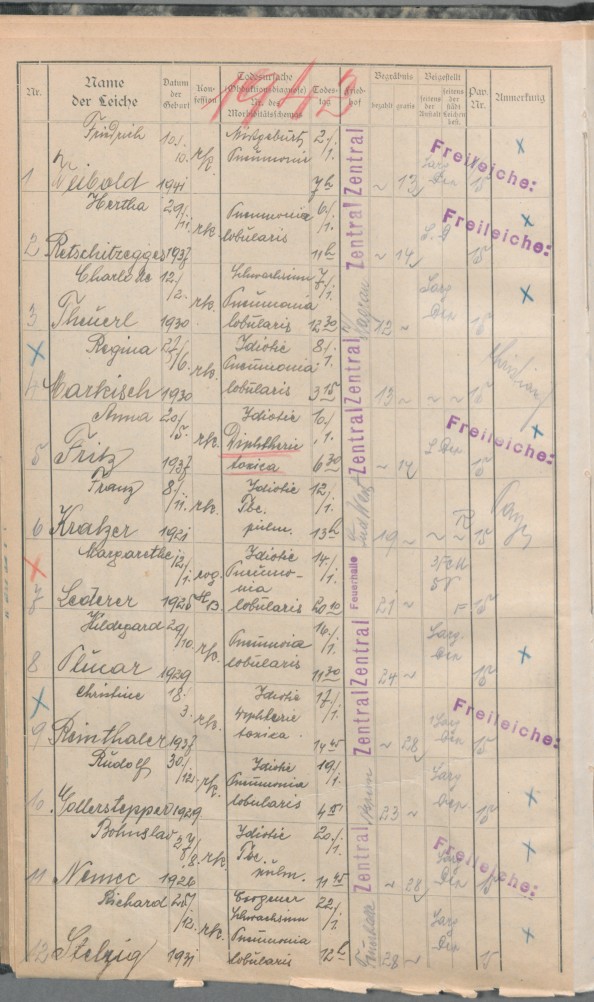Hans Asperger has been portrayed as an opponent of the Nazi regime under which he served. Historical research has now shown that he was instead a well-adapted cog in the machine of a deadly regime. He deliberately referred disabled children to the clinic Am Spiegelgrund, where he knew that they were at risk of being killed. The eponym Asperger’s syndrome ought to be used with awareness of its historical origin.

Hans Asperger, 1980. Photo: Josephinum – Ethics, Collections and History of Medicine, MedUni Vienna.
On 27 June 1941, Herta Schreiber was examined by the Austrian child psychiatrist Hans Asperger (1906–80) at the Universitäts-Kinderklinik in Vienna. The two-year-old girl had sustained a brain injury after falling acutely ill with diphtheria and encephalitis a few months earlier. Asperger noted: ‘Serious personality disorder (post-encephalitic?): major motoric retardation; erethic idiocy; seizures. The child must be an unbearable burden for her mother, who has five healthy children to care for. Permanent placement in Am Spiegelgrund appears absolutely necessary.’
Four days later, Herta was admitted to Am Spiegelgrund, the children’s clinic at the large psychiatric hospital Am Steinhof in Vienna. The hospital consisted of 60 pavilions in the art nouveau style, designed by the famous architect Otto Wagner. One month later, the senior medical officer at Am Spiegelgrund, Erwin Jekelius (1905–52), reported to the National Committee for Scientific Registration of Serious Hereditary and Congenital Diseases in Berlin that Herta suffered from ‘idiocy, seeking no contact with her surroundings’. The National Committee was responsible for the secret Nazi child euthanasia programme. In reality, ‘euthanasia’ was a euphemism for the Nazis’ racial hygiene, eugenic murder programme. Jekelius ticked the boxes on the form indicating that Herta’s condition was incurable and that it would have no effect on her life expectancy. Jekelius was in fact asking for permission to kill Herta. One month later, on 2 September 1941, the day after her third birthday, Herta was put to death. The doctors registered ‘pneumonia’ as the cause of death.
Herta was one of at least 789 children who died in Am Spiegelgrund from July 1940, when the clinic was established, until the fall of the Third Reich. Many of the children were killed. The most common method was to administer a barbiturate, frequently dissolved in cocoa. This strong hypnotic, a drug which is now used to induce narcosis, caused many of the children to die quickly. Those who survived were given repeated doses of the drug and denied food, and died slowly from starvation or infections such as pneumonia.
The history of the role of Nazi doctors in the forced sterilisation and murder of adults and children with various somatic and mental disorders and disabilities is well known. Less well known so far is the role played by Hans Asperger, who later would lend his name to a diagnosis. Asperger largely constructed the image of himself as an opponent of Nazism and as the children’s saviour, an image that was uncritically disseminated in the ensuing period. Two major research works that have examined the same archive material take issue with the embellishment of Asperger’s role during the Nazi era: Edith Scheffer’s book Asperger’s Children: the Origin of Autism in Nazi Vienna (1) and an article by Herwig Czech (2).
Eugenics
Hans Asperger grew up in a peasant family in Hausbrunn in the north-eastern corner of Austria, near the border with Slovakia in the east and the Czech lands in the north. The father, who was never able to realise his dream of becoming a bookkeeper, made strict demands on his son. Ironically, Asperger said later in life that he would never have exposed his family or patients to a similarly rigorous upbringing. Asperger was a devout Catholic, a fact which has been cited as an argument for his innocence (2). According to Czech, this is misleading. Although Asperger never joined the Nazi party, he was a member of several Nazi organisations. Before the Anschluss, Germany’s annexation of Austria in 1938, he was a member of the Catholic youth organisation Bund Neuland, which embodied fascist ideas and pan-Germanic ideology.

Herta Schreiber in Am Spiegelgrund. She was put to death at the age of three, only a couple of months after having been admitted. From Herta Schreiber’s patient records. Photo: Wiener Stadt-und Landesarchiv, Wiener Städtische Nervenklinik für Kinder: A2 – Krankengeschichten verstorbene Mädchen und Knaben, Herta Schreiber.
In the 1920s and 30s, eugenics, the doctrine of how to improve the ‘biological quality’ of the population, was a legitimate ideology dressed up in scientific garb and promoted by a broad political stratum in many European countries, including Norway (3–5). Social hygiene held sway in many European countries, leading to arguments for improvement of public health through social initiatives such as house-building, swimming baths, sewage facilities, day-care centres and schools.
The social hygiene project could also involve recommendations and incentives for population groups with desirable genetic material to continue reproducing, so-called positive eugenics. Some, however, argued for purging of undesirable genetic material, for example through sterilisations (negative eugenics). Here, Norwegian doctors were at the forefront, although there was tension between the proponents of racial hygiene on the one hand and more general eugenics on the other (3–5). The Sterilisation Act of 1934, which allowed for sterilisation with and without consent on social and eugenic grounds, was adopted in the Storting with only a single dissenting vote (6).
During the First World War, the Austrian population suffered great losses. The country was afflicted by hunger, housing shortages, migration and inflation. Scheffer argues that in this situation, a fear arose that the physical health of the population might be at risk: the politicians saw it as their essential task to help build a solid and healthy population. The social context paved the way for proactive, interventionist policies. For example, Julius Tandler (1869–1936), a Jewish doctor and social democrat who was the director of Vienna’s Public Welfare Office, favoured extensive sterilisation of people with ‘unworthy lives’, such as persons with hereditary diseases and physical or cognitive impairments. When Asperger came to Vienna to study medicine in the 1920s, eugenics was well established and accepted in the medical community.
The new experts
In this landscape, a new series of experts on children’s physical and mental health emerged. Among them was Erwin Lazar (1877–1932), paediatrician and founder of the Heilpädagogische Station at the University of Vienna. The philosophy here was to combine the trinity of educational science, psychology and modern medicine to help vulnerable children. Lazar opened the roof of the children’s hospital to let the children play in the open air and have contact with the elements. The distinction between social and medical assessments gradually eroded. With it, new attention was devoted to learning disorders, and new words such as neglect and asociality entered the child psychiatrists’ vocabulary. The genealogy of concepts that continue to circulate in child psychiatry and psychology can be traced back to this period.

‘Stolperstein’ for Alfred Wödl, who was killed in Am Spiegelgrund on 22 February 1941, 16 days after being admitted. Photo: Wikimedia Commons.
In the city where Sigmund Freud was working, psychoanalysis flourished. Psychoanalytic theories of normal human psychology and psychopathology differed from contemporary psychiatry, which relied on physiological experiments and neurology. Like myself, many readers will be surprised by the strong social engagement shown by the psychoanalysts of the time, seen in light of psychoanalytic practice of the day, which (to some extent justifiably, especially in the United States) has been criticised as representing a therapy for the upper classes. During the 1920s and 30s, on Freud’s initiative, twelve psychoanalytically inspired clinics opened across Europe to provide treatment to patients free of charge. In the Vienna clinic, which offered both training of students and treatment of patients, psychoanalysts worked as volunteers; among them were Anna Freud, Erik Erikson, Erich Fromm, Carl Jung and Melanie Klein (7). Although there was sometimes a rigid standoff between psychiatry and psychoanalysis, the development of these disciplines cannot be regarded in isolation. In Vienna there was a widespread exchange of perspectives between them throughout the 1920s. According to Scheffer, this mutually beneficial exchange came to an abrupt end when in 1930 the paediatric hospital appointed a new director, Franz Hamburger (1874–1954), who identified with racial hygiene and became a key spokesman for the budding Nazism. In 1931, at the age of 25 and as a recently graduated doctor, Hans Asperger was employed by the children’s clinic with Hamburger as his superior.
The nazification of medicine – the medicalisation of Nazism
Medicine and psychiatry came to play a decisive role in the Third Reich. Medicine was nazified, but in many ways Nazism was also medicalised. After the Anschluss in 1938, the Nazi and anatomist Eduard Pernkopf (1888–1955) was appointed new dean of the medical faculty of the University of Vienna. He fired nearly 80 % of the faculty’s staff, most of whom were Jews. More than two-thirds of Vienna’s 4 900 doctors and 70 % of the city paediatricians lost their jobs (1, p. 79). This nazification caused a total transformation of Austrian psychiatry: more than 80 % of the members of the Viennese psychoanalytical society were Jews, and the majority succeeded in fleeing from the country.

Eduard Pernkopf’s opening lecture as new dean of the faculty of medicine in Vienna, 26 April 1938. Photo: Österreichische Nationalbibliothek.
Psychiatrists and child psychiatrists played a key role in the Nazi regime and implemented the ideology of racial purity of the Reich. Motorised maternal health care (Gesundheitswagen) was one of the instruments that were used to provide healthcare services to the rural population. While this service was in line with the notions of social hygiene to foster a healthy population, it also functioned as the Nazi regime’s surveillance instrument. Nazi doctors registered and prepared statistics of illness in the population, such as tuberculosis, but they also indexed undesirable persons, such as people with alcoholism and congenital defects. Am Spiegelgrund therefore received not only patients from other clinics, orphanages and practices, but also unwanted children whom the doctors had indexed in the villages. Among them was Marie Fichtinger, a girl born with hemiparesis. In August 1942, on recommendation from the doctors, her father signed a warrant for her transfer to an institution. After her admission to Am Spiegelgrund, Marie was diagnosed with ‘profound idiocy’. Chief medical officer Heinrich Gross sent an application to the National Committee for permission to put her to death. On New Year’s Eve the same year, she was killed.
Asperger was a fierce critic of psychoanalysis and the belief that upbringing and traumas were formative for children’s development, and tended to emphasise biological and constitutional explanations, in line with Nazi racial hygiene (2). Anomalies were explained in terms of a ‘general inferiority of the nervous system’, an idea that shows through in the texts he published after the war (2). His opposition to psychoanalysis and the role of trauma in development of psychopathology is especially evident in his explanation of sexual abuse of children. He claimed that children who were exposed to abuse needed to have an innate disposition, a ‘shamelessness’ that made them attract such incidents. Moreover, children with a ‘healthy personality’ would outgrow even serious sexual traumas (2). There was no conflict between the tradition of which Asperger was a part and a biological understanding of illness. On the contrary, these went hand in hand.
The Nazis wanted to create a pure, able-bodied Volk (people). A key concept in this context was Gemüt, whose dictionary translation is ‘disposition’ or ‘temperament’, but in German this term dates back to the eras of German Enlightenment and Romanticism. Scheffer argues that in the Nazi period, Gemüt changed from being a descriptive concept and an ideal to becoming an instrument that child psychiatrists could use to socialise and mould the individual to the needs of the collective. Gemüt was quantifiable (gemütskalt, Gemütsdefekt, gemütlos, gemütsarm, Gemütsmangel and Gemütstiefe, Gemütsbegabung and Gemütsreichtum), and could be nurtured and learned, for example through community organisations such as the Hitler Youth. It was believed that in autistic children it was exactly this lack of Gemüt that was prominent, a differentness in the ability to make contact with the community. Therefore, the ‘incorrigible’, untreatable children represented a threat to the Reich. Gemüt was a key characteristic of German-ness, and these children therefore represented a violation of the ideology of purity (1, p. 215)

Excerpt from the register of deaths in Am Spiegelgrund. Photo: Wiener Stadt- und Landesarchiv, M.Abt. 209, Wiener Städtische Nervenklinik für Kinder: B4 –Totenbuch.
Asperger took a special interest in children who today might be diagnosed with autism spectrum disorders. In his inauguration thesis Die «Autistischen Psychopathen» im Kindesalter, published in 1944, he described a small group of ‘autistic psychopaths’ whose traits of character were more commendable than those of other children. Their faculty for abstract thinking was so well developed that ‘their relationship to the concrete, to objects and persons, has largely been lost’ (1, p. 170). Such children with special abilities were especially valuable, since they would often end up as highly educated in leading positions in society. Asperger believed that this only applied to boys: ‘the autistic personality is an extreme variant of male intelligence’ and ‘male character’ (1, p. 171). Scheffer here points to a clear gender ideology in Asperger’s thinking. On the one hand, Asperger and his colleagues separated out the children they believed to be curable with the aid of heilpädagogische principles and thus socialised back into the community. These children were valuable. By removing them from their families and strengthening their ties to the community, these children could be saved. The children whom they regarded as ‘lost’, on the other hand, i.e. who were so badly damaged in their social contact with their environment that their prognosis for being able to fulfil a function in Nazi society was poor; they were without value and thus undesirable. Initially they were institutionalised, but starting from 1939 they were put to death by the child euthanasia programme T4. Thirty per cent of those who were killed suffered from physical disabilities, one in ten had Down’s syndrome, others suffered from hydrocephalus, epilepsy, cerebral palsy and other brain injuries or disorders. Socially related ‘coexisting indications’ in the parents, such as alcoholism, speech defects or sexual impulsiveness, were often added to the applications for permission to kill the children (1, p. 185).
Scheffer points to a radical change in Asperger’s writing about the children before and after the Nazis came to power: in 1937 he wrote that ‘it is impossible to establish a rigid set of criteria for a diagnosis’, but in the following year he claimed to be able to identify a ‘well-characterized group of children who we name “autistic psychopaths” ’. In 1941, the ‘autistic psychopaths’ were said to ‘live their own lives without an emotional relationship with the environment’. In 1944, the child is defined in terms of the community: ‘The autist is only himself (autos) and is not an active member of the greater organism which he is influenced by and which he influences constantly’ (1, p. 214).
Scheffer chooses to interpret Asperger’s formulations as expressions of a real change in his views of these children. An alternative interpretation is that he adapted his texts to Nazi ideology and language to protect his own career. Asperger nevertheless remains responsible for his writings. Although he never explicitly wrote that the children with the most severe pathologies ought to be put to death, he referred many of them to Am Spiegelgrund in the full knowledge that children were killed there. Euthanasia of the mentally ill was never referred to explicitly in official documents, perhaps with the exception of those classified as top secret. As Czech writes, mere mention of the possibility of killing patients would constitute a serious violation of state secrecy (2). Therefore, there is no direct evidence that Asperger referred patients to their deaths. However, Czech notes a number of examples showing that there was a general awareness of the euthanasia programme among the citizens of Vienna. He concludes that it is ‘extremely unlikely’ that Asperger, with his unique position and various tasks and contacts, was unaware of what was going on at Am Spiegelgrund. Asperger was free to refer the children to places other than the clinic that was highly likely to put them to death. Czech concludes that Asperger must have seen euthanasia as an acceptable last resort for children with severe disabilities (2).
Bodily, psychological and historic wounds
Life in Am Spiegelgrund was harsh. The children were physically punished, for example by being forced to do push-ups for not having cut their nails or made their bed properly. The nurses could withhold meals. Survivors have reported that they were constantly hungry, and if they vomited, they were forced to eat their vomit. The children were set against each other, so there was no real solidarity between them. For example, bedwetters were lined up in front of the entire dormitory. For those who survived, their stay left them highly traumatised.

The memorial in front of Am Spiegelgrund. Photo: Wikimedia Commons.
Many parents wrote letters in despair (and in vain) to the doctors, pleading to have their children returned to them. However, some wrote thank-you letters to the doctors after the death of their children. Some parents knew what was going on. Herta Schreiber’s patient records note that the mother had tearfully said that ‘if she [Herta] cannot be helped, it would be better if she died. She would not have anything in this world, she would only be ridiculed by others. As the mother of so many other children she would not want that for her, so it would be better if she died.’ (2). The statement testifies to the widespread acceptance of racial hygiene and eugenics in the population, in addition to the lack of institutional places and help for children such as Herta under the Nazi regime (2). Parents of children with functional impairments were not unaffected by the culture and society of which they were part. Herta’s mother was afraid that her daughter would fail to fit into a society where deviations from the norm were unwanted. It reminds us that it is our shared responsibility – as a society – to defend a concept of normality that encompasses the entire spectrum of human nature.
The doctors in the child euthanasia programme claimed to be driven by compassion: ‘With the cases that we had by the dozens in the institution, putting an end to this human wretchedness was an automatic thought’, said Marianne Türk, who was a doctor at Am Spiegelgrund (1, p. 201). During the court proceedings she admitted to having given children lethal injections, but could not recall how many. She was sentenced to ten years in prison and lost her right to practice medicine. In 1957, a committee of professors at the University of Vienna decided to restore her doctoral title to her.
After the war Asperger returned to the Vienna university clinic. He was allowed to keep the academic merit he had earned during the Nazi years, and in 1962 he was appointed chief medical officer at the children’s clinic in Vienna (2). Senior medical officer Heinrich Gross kept the brains of more than 400 children in jars in the basement and used them for research purposes well into the 1980s.
In historiography, the historian will invariably have to choose what kind of source material to highlight, how to weigh the sources against each other, and what kind of narrative will finally emerge. Scheffer’s and Czech’s studies are both extremely thorough, but differ in fundamental respects. Scheffer’s book has a momentum that makes it hard to put down. Despite certain repetitions, it is well written. I nevertheless feel that there is an underlying current of anger in her writing, and I occasionally feel that the picture she draws of Asperger is somewhat monotonous. The fact that Scheffer herself is the mother of a child who has suffered because of the categorising effect of diagnoses is an item of information that I would have liked to see in the preface, not in the final acknowledgements. This does not diminish the credibility of the book, although it makes her engagement more understandable. I feel, though, that Czech presents a story which is more nuanced and more honest regarding what we can or cannot tell based on the sources. Although he concludes that Asperger obviously knew that children were put to death, and that he could have prevented many of them from being sent to Am Spiegelgrund, Czech also makes it clear that Asperger also helped save a number of children. Space is provided for a more complex picture of the Austrian doctor.
Scheffer argues that the story of Asperger, Nazism and the children indicates that we ought to be critical of the diagnosis of autism spectrum disorder. The new knowledge of Asperger’s relationship with Nazism should be added to the curriculum for medical and psychology degrees, and the eponym should be used with awareness of its historical origin. The relevance of Asperger’s relationship to the Nazi regime when it comes to understanding today’s discussions on autism spectrum disorders, which include questions of human normality, neurodiversity, the reliability of diagnostic criteria and the stigmatising effect of diagnoses, is an altogether different matter.
Another point is that Leo Kanner’s study of 11 children from 1943, in which he claimed to have identified ‘a unique “syndrome”, not heretofore reported’, characterised by an ‘extreme autistic aloneness’, gained a far greater importance in English-language medicine than Asperger’s study (8). In 1981, Asperger’s research gained a new lease of life through an article by Lorna Wing, who proposed the term Asperger’s syndrome (9). However, Wing’s description of the syndrome, which differs considerably from Asperger’s, was the start of the syndrome’s expansion as a diagnosis. Asperger’s syndrome first appeared in the diagnostic manuals in 1992 (ICD-10) and 1994 (DSM-IV), but in the DSM-V the diagnosis has been removed and collapsed into the far broader diagnosis of autism spectrum disorder. ICD-11, which is currently out on a consultation round, follows the same pattern.
The prevalence of autism spectrum disorders has increased considerably over many decades. Today, one in every 40 American children has been diagnosed with an autism spectrum disorder (10). In parallel, there has been an explosive increase in references to them in popular-science books and the media (an n-gram in Google Books and the National Library, i.e. showing how often a word occurs in publications in these databases, shows an exponential growth for the terms ‘Asperger’s syndrome’ and ‘autism spectrum’ through the 1990s and 2000s).
The story of Hans Asperger, Nazism, murdered children, post-war oblivion, the birth of the diagnosis in the 1980s, the gradual expansion of the diagnostic criteria and the huge recent interest in autism spectrum disorders exemplify the historical and volatile nature of diagnoses: they are historic constructs that reflect the times and societies where they exert their effect (11). The story of Asperger and Nazism reminds us that the psychiatric notion of illness ought to be kept narrow and defended against medicalisation of ever more areas of human life. This is an endeavour that German academic psychiatry has addressed with the utmost seriousness (12), in awareness of the lessons that history has taught us of how porous the distinction is between medicine and politics, not least in authoritarian regimes.